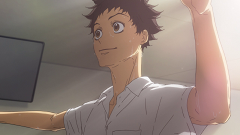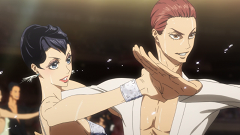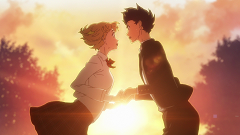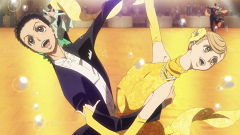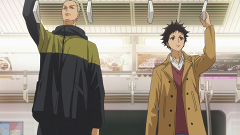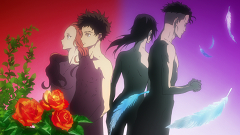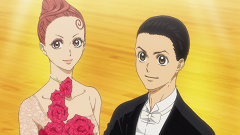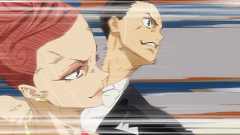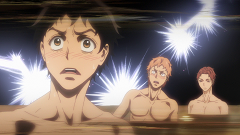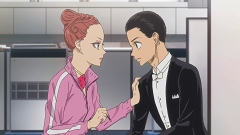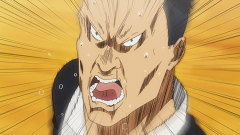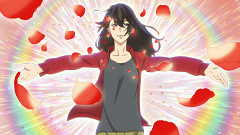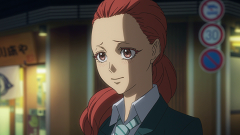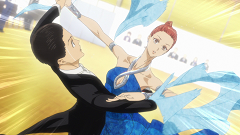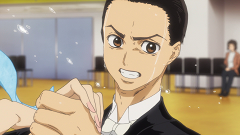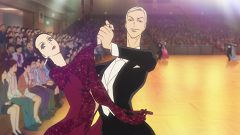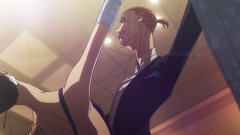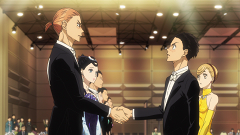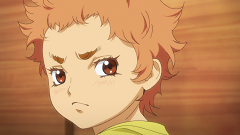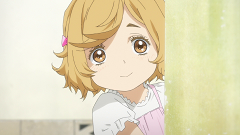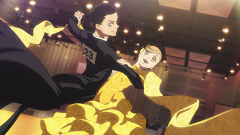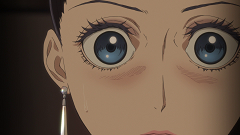In the weeks leading up to the summer 2017 season, Ballroom e Youkoso was one of the most buzzed-about new series. Produced by the Production I.G. team responsible for the smash hit Haikyuu!!, and set to air on Amazon’s brand new Anime Strike service, the series had no shortage of promotion or hype behind it. All that remained was for the creative staff to carefully transfer Takeuchi Tomo’s manga to the small screen, and they mostly succeeded – at least, in conveying its individual images and moments. But sports anime have evolved beyond an upper limit of simple panel-by-panel adaptations, and in the end, Ballroom didn’t manage to keep pace with its contemporaries. While its characters deserve some praise, both for their designs and their personalities, the series is limited by shounen clichés, haphazard progression, and an inadequate sense of movement during dance competitions.
The show’s lead character is one Fujita Tatara, whose general listlessness is gradually transformed into passion after he accidentally discovers ballroom dance. Tatara’s timid nature stands in stark contrast to the more dominant personalities he encounters throughout the series, and the show makes good use of that difference to portray Tatara’s personal growth in tandem with his improvement as a dancer. Though he is initially intimidated by rival characters both aloof and hotheaded, he learns from and ultimately befriends them as the series goes along. His relationships with three girls, all of whom serve as his dancing partner for some length of time, are even more central to Ballroom’s formula. Tatara struggles with the traditional notion of male-dominated performances, and aims to cooperate with his partners as best he can. There might have been some interesting social commentary to be had here, but the show smothered that potential during its second half by pushing the idea that its protagonist ought to become a perfect leader, but never satisfactorily explaining what that meant or how to do it.
Despite some muddled goal-setting, Ballroom’s characters are fun to spend time with, and worth learning about in detail. The show frequently explores performance anxiety, feelings of inferiority and stagnation, and even digs into the dark personal lives of its cast once or twice. But more common than these positive tendencies are competition-interrupting flashbacks and clunky comments from nameless observers, which become more common and more frustrating the longer the show goes on. Even Tatara’s biggest rival, an unflappable genius by the name of Hyodo Kiyoharu, begins seeing into the heads of other dancers by the show’s end, describing exactly what they’re feeling and perfectly evaluating their performances as a stand-in for the writers. This may have been necessary, however, in light of the show’s most glaring issue – for a show about ballroom dance, there isn’t nearly enough dancing to be found.
Many of the show’s problems intensify in its second half, but its poor dance animation is more noticeable in the early episodes. Even with an eventual uptick in the number of prolonged choreographed sequences, however, the damage is done at the start, with plenty of panning stills, reaction shots, CG dancers, and speed lines instead of honest-to-goodness dancing. Audience members aren’t given a proper introduction to the sport in motion, so we have to fall back on snippets of verbal speculation about whose stamina is giving out, or whether Tatara has finally learned how to execute a proper hold. This robs several key scenes of the impact they deserve, though others are bolstered by Ballroom’s frequent use of visual metaphor during competitions. If you cut your teeth on sports anime from the 90’s or early 2000’s, these techniques may not be too bothersome, but fans of newer titles in the genre may find the lack of dynamic movement disappointing.
This aspect of the show does improve as the series draws to a close, but there’s a trade-off to be made. Several characters are marginalized to make room for a brash newcomer, and her transition from manga to anime is less than seamless. The series also succumbs to a shounen tradition with which most anime fans will be quite familiar, though for the sake of potential viewers I won’t get too specific. Still, Ballroom ends well, and my original affection for the show did return for the final episode, so there’s reason to hang in there if you’re already halfway done. There’s little hope for a season 2, based on the lack of remaining source material, but if you’re reading this in the future and a sequel has emerged, you may be wondering whether the original is worth your time. My advice: if you’re a fan of sports anime, sample three episodes and see how you like it. Otherwise, give this one a pass.

